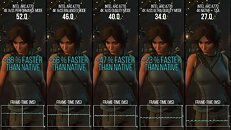- Joined
- Oct 9, 2007
- Messages
- 47,617 (7.44/day)
- Location
- Dublin, Ireland
| System Name | RBMK-1000 |
|---|---|
| Processor | AMD Ryzen 7 5700G |
| Motherboard | Gigabyte B550 AORUS Elite V2 |
| Cooling | DeepCool Gammax L240 V2 |
| Memory | 2x 16GB DDR4-3200 |
| Video Card(s) | Galax RTX 4070 Ti EX |
| Storage | Samsung 990 1TB |
| Display(s) | BenQ 1440p 60 Hz 27-inch |
| Case | Corsair Carbide 100R |
| Audio Device(s) | ASUS SupremeFX S1220A |
| Power Supply | Cooler Master MWE Gold 650W |
| Mouse | ASUS ROG Strix Impact |
| Keyboard | Gamdias Hermes E2 |
| Software | Windows 11 Pro |
Intel XeSS is a second-generation upscaling technology that's at par with DLSS 2.0 and FSR 2.0, says Digital Foundry, which got an exclusive early-access an Arc A770 graphics card along with XeSS, and the latest version of "Shadow of the Tomb Raider," which features XeSS besides DLSS. The publication compared the A770 + XeSS with a GeForce RTX 3070 + DLSS, and in its testing, found XeSS to offer comparable or better image quality at low frame-times. XeSS uses a AI-ML algorithm to reconstruct details, which is accelerated by the XMX cores on Xe-HPG "Alchemist" GPUs. XeSS hence currently only supports Arc GPUs, however, the company is working on a DP4a (programming model) version so XeSS could work on other GPU architectures, across brands.
An upscaling algorithm by design adds to frame-times (time taken to render a frame to display), and in Digital Foundry's testing, the most aggressive preset of XeSS, Performance, which upscales 720p to 1440p, adds 2 ms to the frame-time. A 1080p to 4K upscaling in the same mode, adds 3.4 ms to the frame-time, which jumps from 8.8 ms to 12.2 ms (an increase of 3.4 ms). The increase in frame-times is a good trade-off when you consider the performance gained—a staggering 88 percent increase in frame-rates for 1080p to 4K upscaling, and 52 percent increase with 720p to 1440p upscaling. Frame-times increase as you move up the presets toward the Quality mode, which renders the game at resolutions closer to native-resolution, so the performance-gained is smaller. XeSS offers a preset it calls "Ultra Quality," which renders the game at a resolution closest to native, while still yielding a 16-23 percent frame-rate gain, with an output that's practically indistinguishable from native-resolution.



View at TechPowerUp Main Site | Source
An upscaling algorithm by design adds to frame-times (time taken to render a frame to display), and in Digital Foundry's testing, the most aggressive preset of XeSS, Performance, which upscales 720p to 1440p, adds 2 ms to the frame-time. A 1080p to 4K upscaling in the same mode, adds 3.4 ms to the frame-time, which jumps from 8.8 ms to 12.2 ms (an increase of 3.4 ms). The increase in frame-times is a good trade-off when you consider the performance gained—a staggering 88 percent increase in frame-rates for 1080p to 4K upscaling, and 52 percent increase with 720p to 1440p upscaling. Frame-times increase as you move up the presets toward the Quality mode, which renders the game at resolutions closer to native-resolution, so the performance-gained is smaller. XeSS offers a preset it calls "Ultra Quality," which renders the game at a resolution closest to native, while still yielding a 16-23 percent frame-rate gain, with an output that's practically indistinguishable from native-resolution.



View at TechPowerUp Main Site | Source






